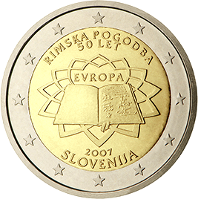 |
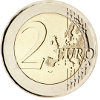 |
C o m m e m o r a t i v e
C o i n s |
||
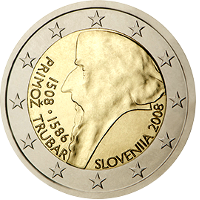 🔎
🔎 |
 |
Slovenia | 26 May 2008 | 500th birthday of Primož Trubar |
20001 20002 20005 |
1,000,000 |  |
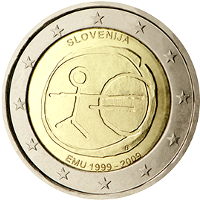 🔎
🔎 |
 |
Slovenia | 05 Jan. 2009 | 10th anniversary of the Economic and Monetary Union (EMU) |
20001 20002 20005 |
1,000,000 |  |
National characteristics : Above is the name of the issuing country "SLOVENIJA" (Slovenia), the acronym of the occasion of issue below is "EMU". The coin was minted without mint marks by the Finnish mint Suomen Rahapaja OY in Vantaa. |
|||||||
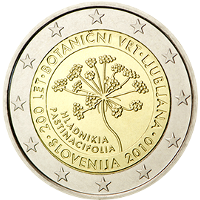 🔎
🔎 |
 |
Slovenia | 10 May 2010 | 200th anniversary of the Botanical Garden of Ljubljana |
20001 20002 20005 |
1,000,000 |  |
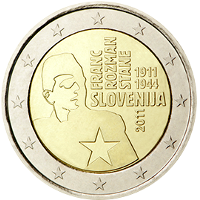 🔎
🔎 |
 |
Slovenia | 21 Mar. 2011 | 100th birthday of Franc Rozman — Stane |
20001 20002 20005 |
1,000,000 |  |
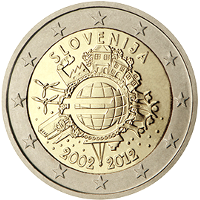 🔎
🔎 |
 |
Slovenia | 03 Jan. 2012 | 10th anniversary of the Euro‐Currency |
20001 20002 20005 |
1,000,000 |  |
National characteristics : At the top of the coin is the name of the issuing country "SLOVENIJA" (Slovenia). The coin was minted without mint marks by the Slovak Mint Mincovňa Kremnica, š.p. in Kremnica. |
|||||||
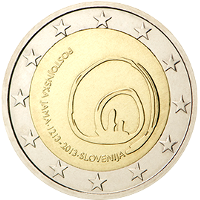 🔎
🔎 |
 |
Slovenia | 04 Feb. 2013 | 800 years since the discovery of the Postojna Cave |
20001 20002 20005 |
1,000,000 |  |
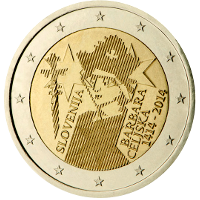 🔎
🔎 |
 |
Slovenia | 17 Nov. 2014 | 600th anniversary of the Coronation of Barbara of Celje |
20001 20002 20005 |
1,000,000 |  |
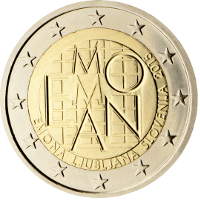 🔎
🔎 |
 |
Slovenia | 09 Nov. 2015 | Bimillenary of the foundation of Emona |
20001 20002 20005 |
1,000,000 |  |
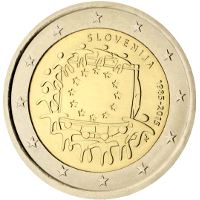 🔎
🔎 |
 |
Slovenia | 07 Dez. 2015 | 30th anniversary of the EU‐Flag |
20001 20002 20005 |
1,000,000 |  |
National characteristics : Above is the name of the issuing country "SLOVENIJA" (Slovenia), followed by the dates "1985‐2015". The coin was minted without mint marks by the Italian mint Istituto Poligrafico e Zecca dello Stato in Rome. |
|||||||
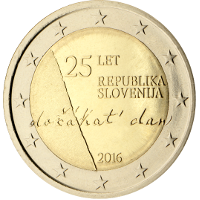 🔎
🔎 |
 |
Slovenia | 20 Jun. 2016 | 25th anniversary of independence of the Republic of Slovenia |
20001 20002 20005 |
1,000,000 |  |
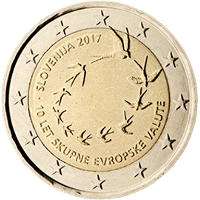 🔎
🔎 |
 |
Slovenia | 02 Feb. 2017 | 10th anniversary of the adoption of the Euro in Slovenia |
20001 20002 20005 |
1,000,000 |  |
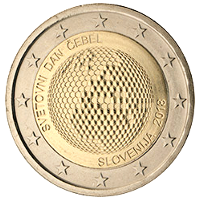 🔎
🔎 |
 |
Slovenia | 14 May 2018 | World Bee Day |
20001 20002 20005 |
1,000,000 |  |
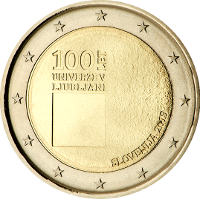 🔎
🔎 |
 |
Slovenia | 25 Nov. 2019 | 100 years since the foundation of the University Ljubljana |
20001 20002 20005 |
1,000,000 |  |
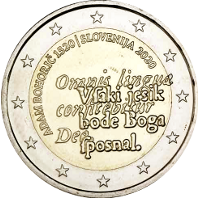 🔎
🔎 |
 |
Slovenia | 23 Dec. 2020 | 500th anniversary of the birth of Adam Bohorič |
20002 20007 20008 |
1,000,000 |  |
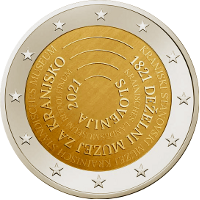 🔎
🔎 |
 |
Slovenia | 25 Oct. 2021 | 200th anniversary of the establishment of the Carniola Provincial Museum |
20002 20003 20005 |
1,000,000 |  |
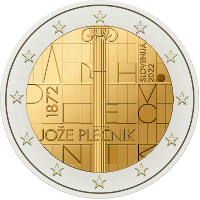 🔎
🔎 |
 |
Slovenia | 02 Mar. 2022 | 150th birthday of the architect Jože Plečnik |
20002 20003 20005 |
1,000,000 |  |
 Work in progress |
|||||||
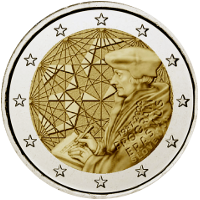 🔎
🔎 |
 |
Slovenia | 01 Jul. 2022 | 35th anniversary of the Erasmus Program |
20003 20005 20009 |
1,000,000 |  |
National characteristics : The quarter circle at the bottom right has four lines; below the commemorative period, the occasion of issue "PROGRAM ERASMUS" (Erasmus programme in Slovenian), below that the issuing country "SLOVENIJA" (Slovenia). The coin was produced without a mint mark by the Slovak mint Mincovňa Kremnica š.p. in Kremnica. The coin belongs to those with a more structured background. |
|||||||
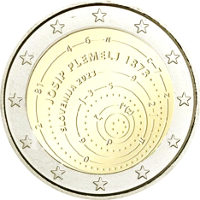 🔎
🔎 |
 |
Slovenia | 19 Dec. 2023 | 150th birthday of Josip Plemelj |
20003 20005 |
1,000,000 |  |
 Work in progress |
|||||||
| References : | |||
| 20001 | Images taken with authorisation by the ECB ‐ Mail dated 20.Feb.2020 © "European Central Bank" |
20002 | Data mirrored from Wikipedia Page "2_euro_commemorative_coins" with friendly support of the guardians of that page. |
| 20003 | Images taken with authorisation by H....... Hamburg | 20004 | Coloured version of this Commemorative Coin in circulation EU‐legal‐technical specifications do not recongnise colour prints. The EU nevertheless tolerates them, as their numbers are very small and they are sold in special packs and therefor are very unlikely to be used as currency. |
| 20005 |
enlarged Images taken with authorisation by Gerd Seyffert © "Gerd Seyffert 2021" |
20006 | Not Applicable |
| 20007 | Images taken by Münzen Kreuzberg © "Münzen Kreuzberg 2021" |
20008 | enlarged Images taken by Münzen Kreuzberg © "Münzen Kreuzberg 2021" |
| 20009 | Text with kind permission by Gerd Seyffert © "Gerd Seyffert 2023" |
20010 | Not Applicable |
 |

